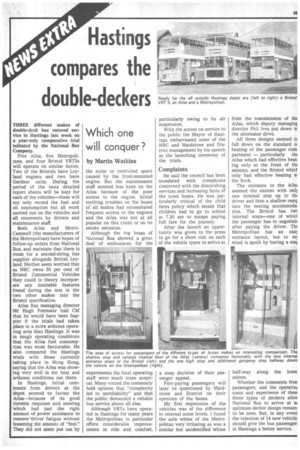Hastings compares the double-deckers
Page 27

If you've noticed an error in this article please click here to report it so we can fix it.
Which one will conquer?
by Martin Watkins
THREE different makes of double-deck bus entered service in Hastings last week on a year-only comparative trial Initiated by the National Bus Company.
Five Ailsa, five Metropolitans, and four Bristol VRT3s will operate on similar duties. Two of the Bristols have Leyland engines and two have Gardner units. During the period of the tests detailed report sheets will be kept for each of the vehicles—these will not only record the fuel and oil consumption but all work carried out on the vehicles and all comments by drivers and maintenance staff.
Both Ailsa and MetroCammell (the manufacturers of the Metropolitan) have hopes of follow-up orders from National Bus, and maintain that there is room for a second-string bus supplier alongside British Leyland. Neither seem worried that as NBC owns 50 per cent of Bristol Commercial Vehicles they could in theory incorporate any desirable features found during the test in the two other makes into the Bristol specification.
Ailsa Bus managing director Mr Hugh Forrester told CM that he would have been happier if the trials had taken place in a more arduous operating area than Hastings. It was in tough operating conditions that the Ailsa fuel consumption was most favourable. He also compared the Hastings trials with those currently ,taking place in Hcng Kong, Saying that the Ailsa was showling very well in the heat and arduous conditions out there.
In Hastings, initial comMents from drivers at the depot seemed to favour the Ailsa—because of its good throttle response and steering 'which had just the right 'amount of power assistance to remove 'driver fatigue without 'lessening the amount of "feel." They did not seem put out by the noise or restricted space caused by the front-mounted engine. But the maintenance staff seemed less keen on the Ailsa because of the poor access to the engine. Initial teething troubles on the buses of all makes had necessitated frequent access to the engines and the Ailsa was not at all popular on this count or on its smoke emission.
Although the top brass of National Bus showed a great deal of enthusiasm for the experiments the local operating staff were much more sceptical. Many voiced the commonly held opinion that "complexity led to unreliability" and that the public demanded a reliable bus service above all else.
Although VRTs have operated in Hastings for many years the Metropolitan in particular offers considerable improvements in ride and comfort, particularly owing to its air suspension.
With the accent on service to the public the Mayor of Hastings embarrassed some of the NBC and Maidstone and District management by his speech at the launching ceremony of the trials.
Complaints
He said the council has been inundated with complaints concerned with the diminishing services and increasing fares of the town buses. He was particularly critical of the child fares policy which meant that children had to go to school at 7.30 am to escape paying full fare for the journey.
After the launch an opportunity was given to the press to go for a short ride on each of the vehicle types to arrive at a snap decision of their passenger appeal.
Fare paying passengers will later be questioned by Maidstone and District on their opinions of the buses.
My first impression of the vehicles was of the difference in internal noise levels. I found the axle whine of the Metropolitan very irritating as was a similar but unidentified whine from the transmission of thE Ailsa, which deputy managinf director Phil Ives put down tc the alternator drive.
All three designs seemed tc fall down on the standard oi heating of the passenger com. partment — particularly th( Ailsa which had effective heat. ing only at the front of th( saloons, and the Bristol whict only had effective heating al the back.
The entrance to the Ailsz seemed the easiest with on13 one internal step up to tin driver and then a shallow raml into the seating accommoda tion. The Bristol has twt internal steps—one of whid the passenger has to negotiat( after paying the driver. Th( Metropolitan has an eas3 entrance layout, but to m3 mind is spoilt by having a stel half-way along the lowe saloon.
Whether the comments fron passengers, and the operatini costs and experience of thes1 three types of deckers alloy National Bus to arrive at ai optimum decker design remain: to be seen. But, in any event the injection of 14 new vehicle should give the bus passenger in Hastings a better service.




























































































